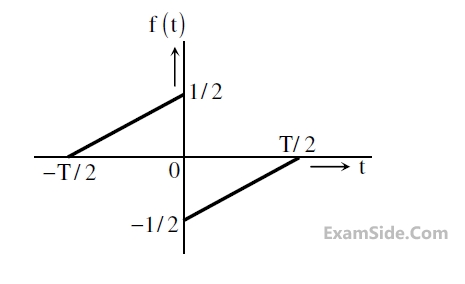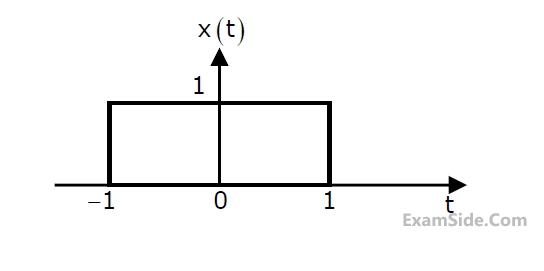Marks 1
1
Let $X(\omega)$ be the Fourier transform of the signal
$x(t) = e^{-t^4} \cos t, \quad -\infty < t < \infty$.
The value of the derivative of $X(\omega)$ at $\, \omega = 0$ is ______ (rounded off to 1 decimal place).
GATE EE 2024
2
A function f(t) is shown in the figure.
 The Fourier transform F($$\mathrm\omega$$) of f(t) is
The Fourier transform F($$\mathrm\omega$$) of f(t) is
 The Fourier transform F($$\mathrm\omega$$) of f(t) is
The Fourier transform F($$\mathrm\omega$$) of f(t) is
GATE EE 2014 Set 3
3
A signal is represented by $$$x\left(t\right)=\left\{\begin{array}{l}1\;\;\;\left|t\right|\;<\;1\\0\;\;\;\left|t\right|\;>\;1\end{array}\right.$$$
The Fourier transform of the convolved signal y(t)=x(2t) * x(t/2) is
GATE EE 2014 Set 3
Marks 2
1
An ideal low pass filter has frequency response given by
$$
H(j \omega)= \begin{cases}1, & |\omega| \leq 200 \pi \\ 0, & \text { otherwise }\end{cases}
$$
Let $h(t)$ be its time domain representation. Then $h(0)=$ ____________ (round off to the nearest integer)
GATE EE 2025
2
Let an input x(t) = 2 sin(10$$\pi$$t) + 5 cos(15$$\pi$$t) + 7 sin(42$$\pi$$t) + 4 cos(45$$\pi$$t) is passed through an LTI system having an impulse response,
$$h(t) = 2\left( {{{\sin (10\pi t)} \over {\pi t}}} \right)\cos (40\pi t)$$
The output of the system is
GATE EE 2022
3
Suppose x1(t) and x2(t) have the Fourier transforms as shown below.
 Which one of the following statements is TRUE?
Which one of the following statements is TRUE?
 Which one of the following statements is TRUE?
Which one of the following statements is TRUE?GATE EE 2016 Set 1
4
Consider a signal defined by $$$x\left(t\right)=\left\{\begin{array}{l}e^{j10t}\;\;\;for\;\left|t\right|\leq1\\0\;\;\;\;\;\;\;for\;\;\left|t\right|>1\end{array}\right.$$$
Its Fourier Transform is
GATE EE 2015 Set 2
5
A 10 kHz even-symmetric square wave is passed through a bandpass filter with centre
frequency at 30 kHz and 3 dB passband of 6 kHz. The filter output is
GATE EE 2014 Set 2
6
A differentiable non constant even function x(t) has a derivative y(t), and their respective
Fourier Transforms are X($$\omega$$) and Y($$\omega$$). Which of the following statements is TRUE?
GATE EE 2014 Set 3
7
Let f(t) be a continuous time signal and let F($$\omega$$) be its Fourier Transform defined by $$F\left(\omega\right)=\int_{-\infty}^\infty f\left(t\right)e^{-j\omega t}dt$$. Define g(t) by $$g\left(t\right)=\int_{-\infty}^\infty F\left(u\right)e^{-jut}du$$. What is the relationship between f(t) and g(t)?
GATE EE 2014 Set 1
8
The Fourier transform of a signal h(t) is $$H\left(j\omega\right)=\left(2\cos\omega\right)\left(\sin2\omega\right)/\omega$$. The value of h(0) is
GATE EE 2012
9
x(t) is a positive rectangular pulse from t = -1 to t = +1 with unit height as shown
in the figure. The value of $$\int_{-\infty}^\infty\left|X\left(\omega\right)\right|^2d\omega$$ {where X($$\mathrm\omega$$) is the Fourier transform of
x(t)} is


GATE EE 2010